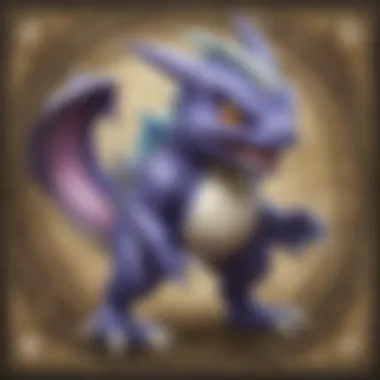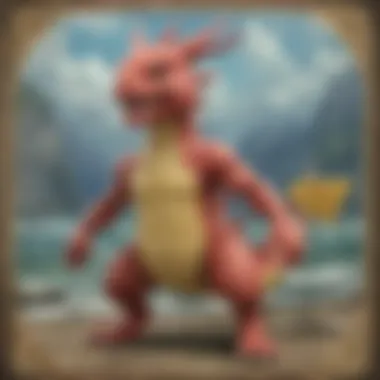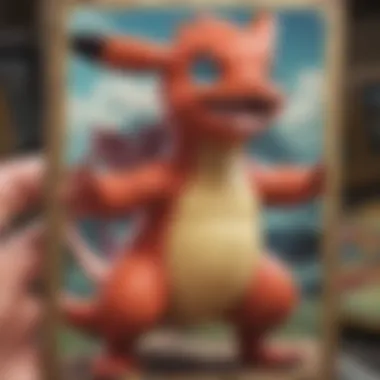Understanding the Current Valuation of Pokémon Cards


Intro
The valuation of Pokémon cards has sparked interests among collectors, hobbyists, and investors alike. Understanding the current market landscape is crucial for anyone involved in the buying or selling of these cards. The interplay between rarity, condition, and demand outlines values in dynamic ways. Interesting prices realized at auctions can create buzz in the community, affecting both novice collectors and seasoned veterans. This article aims to provide insights into how to approach Pokémon card valuation effectively.
Pokémon Card Market Overview
The Pokémon card market has evolved significantly since its inception in the late 1990s. At first glance, it may seem like a child's game, yet it has transformed into a lucrative market. Following the competitive success of the Pokémon video games, the trading card game gained traction. Initial release sets, such as the Base Set, introduced iconic cards, including the ever-popular Charizard.
"The price of cards like Charizard can fluctuate drastically, affecting overall trends in the market."
Key Factors Influencing Prices
- Rarity: Cards that are produced in limited quantities are often more valuable. For example, the Pikachu Illustrator card, with only 39 copies known, commands incredibly high prices.
- Condition: The state of a card plays a vital role in its valuation. Cards are often graded by services like PSA and Beckett, which can elevate a card's worth significantly depending on its grade.
- Popularity and Nostalgia: High demand for nostalgic cards can drive prices up. The cultural impact of Pokémon remains strong, especially with recent anniversaries and new releases capturing attention.
Notable Sales Trends
Recent years have shown remarkable sales trends in Pokémon cards. Record-breaking auctions demonstrate that certain cards can sell for hundreds of thousands of dollars. For example, a 1999 Charizard card sold for over $300,000 in a recent auction. Such staggering figures attest to both market volatility and genuine collector interest.
Emerging Market Dynamics
- Digital Transformation: Online platforms like eBay and Facebook Marketplace have made buying and selling easier, leading to increased participation.
- COVID-19 Pandemic Impact: During lockdowns, many turned to hobbies, with trading cards seeing a resurgence in popularity.
Tips for Buyers and Sellers
Navigating the collectibles market can be daunting. Here are some essential tips:
- Research: Stay informed about specific cards and market trends. Websites like Wikipedia, Britannica, and forums like Reddit can be useful.
- Condition and Grading: Always verify a card's condition before purchase. Investing in cards with higher grades can be a more stable choice.
- Timing: Keep an eye on market trends to know when to buy or sell. Prices can fluctuate based on external factors, including nostalgia waves or anniversaries.
Moving forward, we will delve deeper into the historical contributions of Pokémon cards and elaborate on how to assess their value accurately. Understanding these nuances can enhance your approach to collecting or investing, tailored specifically for fans of all ages.
Preamble to Pokémon Card Valuation
Understanding the valuation of Pokémon cards is crucial in the dynamic landscape of collectibles. The values of these cards are not static; they fluctuate based on various factors. The market is influenced by rarity, demand, condition, and trends. With the resurgence of collecting culture, more individuals are interested in both buying and selling cards. A precise grasp of valuation equips collectors and investors to navigate this evolving market efficiently.
Understanding Pokémon Cards as Collectibles
Pokémon cards have become significant collectibles since their introduction in the late 1990s. Initially appealing to children, the hobby has expanded to adults who see value in nostalgic items. Collecting these cards offers an avenue for personal expression and investment potential. Each card tells a story and can evoke memories associated with the franchise. The emotional connection plays a large role in how enthusiasts perceive the worth of their collections.
The concept of collecting is rooted in a few core principles. First, rarity significantly boosts a card's value. Limited edition releases or cards from earlier sets often command higher prices. Additionally, many collectors focus on specific sets, characters, or types of cards like holographic or full art specimens. This focused collecting behavior reflects personal preferences and influences the popularity of specific cards over time.
The Evolution of Pokémon Card Market
The market for Pokémon cards has transformed dramatically over the years. Initially, the trading card game served merely as a diversion. However, as the digital age advanced, the awareness surrounding these collectibles grew. Online platforms facilitate the buying and selling of cards, making it easier for collectors to connect globally. Consequently, prices have surged, particularly for iconic cards from the first few sets.
In recent years, several factors have contributed to shifting market trends. For instance, the rise of social media platforms such as Reddit and Facebook has created communities where collectors share knowledge, trends, and valuations. As a result, cards previously seen as mundane have risen in status. Moreover, notable auction results, such as the sale of a Pikachu Illustrator card, indicate the potential for record-breaking prices in the marketplace.
Understanding these dynamics is essential for newcomers and veteran collectors alike. As the landscape continues to change, staying informed about market movements and trends is vital for successful engagement in the Pokémon card community.
Key Factors Influencing Pokémon Card Prices
The valuation of Pokémon cards is determined by a complex interplay of several key factor. Each element plays a critical role in shaping the prices within the marketplace. By understanding these elements, collectors and investors can make informed decisions when buying or selling.


Rarity and Scarcity
Rarity is a fundamental aspect that influences the price of Pokémon cards. The concept covers how many copies of a specific card exist. Some cards are released in very limited quantities, while others are printed in large numbers. Limited edition cards, promotional releases, and specific series often have lower supply, which enhances their desirability among collectors. Scarcity creates a sense of urgency among buyers, which can drive up prices significantly.
Moreover, certain cards from earlier sets, such as the Base Set, tend to be more valued because fewer exist in mint condition today. For instance, the holographic Charizard card is often cited as an exempler of rarity contributing to its high market value. Thus, identifying rare cards in a collection is crucial for assessing overall worth.
Condition and Grading
Condition is another essential factor. The state of a card—whether it's near mint, lightly played, or heavily damaged—can drastically affect its value. Cards in optimal condition generally fetch higher prices because collectors prefer products that look good. To standardize the assessment of condition, grading services have emerged. These services evaluate the state of the card and assign a grade based on defined criteria. A card graded 10 by PSA, for example, is perceived as perfect, resulting in significantly higher market worth compared to a card with a lower grade.
In this regard, grading is not merely a form of appraisal; it is also a vital tool for ensuring confidence in transactions. If a collector sees that a card has been graded by a reputable service, its worth becomes more transparent and trustworthy.
Market Demand Dynamics
Lastly, the dynamics of market demand play a critical role in influencing Pokémon card prices. The popularity of Pokémon as a franchise impacts buyer interest. Increased engagement through new game releases or the revival of nostalgia can lead to sudden surges in demand for specific cards or collections. The emergence of social media also allows enthusiasts to share their collections, which can further elevate demand for particular pieces.
Quote: "Market demand is subject to change; a card valued highly today may see fluctuations as interest in the franchise evolves."
Tracking sales trends through various platforms, like eBay or social media marketplaces, helps collectors and investors stay informed of what is hot in the current market. Understanding these patterns allows sellers to time their sales appropriately, maximizing potential profits.
By evaluating rarity, condition, and demand dynamics, individuals can navigate the evolving landscape of Pokémon card valuation more effectively, ensuring that they make informed decisions in this intricate market.
Understanding Pokémon Card Grades
Grading plays a critical role in determining the value of Pokémon cards. It is essential for both sellers and buyers in the collectible market. Understanding how grades are assigned can greatly enhance a collector's ability to assess the worth of cards in their inventory.
A card's grade reflects its condition and any flaws that may exist. This system provides a standardized way to evaluate cards, which is beneficial in a market where visual differences can be subtle yet significant. The grading process involves careful examination by trained professionals. These experts look at the surface, corners, edges, and centering of each card. The result of this evaluation often influences the market price dramatically.
Knowing about grades aids collectors in making informed decisions. High-grade cards, especially older ones, can fetch impressive prices due to their scarcity and demand. Alternatively, cards with lower grades may not hold the same value, but they can still be valuable to collectors looking for specific artwork or histories. Understanding the grading system allows collectors to navigate the market more effectively, whether they are buying or selling.
The Grading Process Explained
The grading process involves multiple steps that help to ensure the integrity and accuracy of the evaluation. Here are the primary steps:
- Submissions: Collectors submit cards to a grading service. The submission includes fees, which vary by service and priority level.
- Examination: Trained graders examine the submitted cards under magnification. They assess the surfaces for scratches, stains, or any wear.
- Grading Scale: Graders utilize a common grading scale from 1 to 10. A grade of 10 indicates a perfect card, while lower grades signify increasing levels of imperfection.
- Encapsulation: Once graded, the card is encapsulated in a tamper-evident holder, which provides protection and showcases the grade prominently.
- Report Issuance: A detailed report accompanies the graded card. It describes the card's attributes and any detected imperfections.
The meticulous nature of this process ensures that both buyers and sellers possess accurate information regarding the card's condition.
Popular Grading Services
Several grading companies have established themselves within the Pokémon card community. Each service has its own criteria and grading nuances. Here are a few well-known grading services:
- Professional Sports Authenticator (PSA): One of the most recognized grading companies. It offers a dual grade for centering and overall conditions.
- Beckett Grading Services (BGS): Known for its strict grading standards and unique sub-grades system.
- Certified Guaranty Company (CGC): Another notable service, focusing on comic books and trading cards alike, providing detailed assessments.
These grading services vary in reputation and efficiency. Selecting a reputable grading service can significantly affect a card's resale value and marketability.
Popularity among these services also influences how enthusiasts perceive cards from different grades. Individuals aiming to buy or sell should keep this in mind when assessing potential transactions.
Current Market Valuation Trends
Understanding current market valuation trends of Pokémon cards is critical for anyone interested in the collectibles landscape. The Pokémon card market has evolved significantly, and being aware of these trends helps buyers and sellers navigate the complexities of pricing. This section covers notable recent high-value sales and shifts in the collectibles market.
Recent High-Value Sales


The past few years have seen remarkable high-value sales of Pokémon cards, some reaching astronomical prices. For example, the sale of a Shadowless Pikachu Illustrator card for $5.275 million in 2021 set a benchmark for rarity and desirability among collectors. Such sales demonstrate not only the intrinsic value of these cards but also the growing interest among investors.
These high-ticket sales have ignited the market, leading many to seek rare cards as both collectibles and investments. The significant values attached to these card sales reflect a blend of emotional nostalgia and potential ROI.
Key takeaways from recent high-value sales include:
- The impact of rarity: Cards that are limited in quantity fetch higher prices.
- Graded cards outperform non-graded ones: Investors seek assurance in the condition of their collectibles.
- Celebrity endorsements: When prominent figures, such as athletes or entertainers, share their collections, market interest climbs.
"The worth of a Pokémon card is not just in its age or rarity but in the story it tells within the collector community."
Shifts in Collectibles Market
The collectibles market as a whole has undergone noticeable shifts, and Pokémon cards are no exception. Initially, Pokémon cards were seen primarily as children’s toys, but today they are viewed through the lens of investment and nostalgia. More people are turning to collectibles like Pokémon cards as stock markets fluctuate and traditional investments face uncertainty.
A few notable trends include:
- Increased Online Activity: Platforms such as auction sites and marketplaces have grown. Collectors now have access to a vast array of resources for buying and selling.
- Emergence of NFTs: Digital cards and assets are gaining traction, altering the perception and means of valuation. These expand the conventional understanding of what constitutes a collectible.
- Crossover Appeal: Interest from diverse demographics, including those who played the game as children and newly interested investors. This broad spectrum elevates demand and valuation pathways.
The current valuation trends of Pokémon cards provide insights into shifting perceptions. As collectors redefine what it means to collect, the market adapts, ensuring that Pokémon cards remain relevant in the collectibles landscape.
Popular Pokémon Cards and Their Values
Understanding popular Pokémon cards and their current market values is crucial for collectors and enthusiasts alike. This knowledge informs one’s purchasing or selling decisions and assists in building a valuable collection. With the rise in the popularity of Pokémon cards, several cards stand out, both for their nostalgic value and their investment potential. These cards often embody historical significance, distinct artwork, and rarity, making them essential within the trading card game (TCG) community.
Iconic Cards in the Pokémon TCG
Iconic cards in the Pokémon TCG have made a significant impact on the market. These cards are often characterized by their unique features, such as special illustrations or unique attributes in gameplay. For instance, the Pikachu Illustrator card, originally awarded in a contest, is one of the most sought-after cards in history. It is noteworthy because of its limited distribution and is often valued in the six-figure range.
Other notable cards include the Charizard (1st Edition), which remains a fan favorite for its powerful gameplay characteristics and nostalgic connection to the franchise's early days. This card has frequently sold for tens of thousands of dollars, especially in top condition.
Another well-known card includes the Shadowless Holo Charizard, which holds immense value because of its scarcity and the iconic character itself. These cards reflect more than just gameplay; they represent the evolution of the Pokémon phenomenon and the intense nostalgia that many collectors feel.
"The market for iconic Pokémon cards reflects both historical significance and emotional attachment within the community."
Recent Favorites Among Collectors
In addition to these iconic cards, recent favorites among collectors have surfaced due to trends and new releases in the Pokémon TCG. Cards from special sets or promotional events often gain popularity. For example, the Shiny Charizard VMAX card from the Shining Legends set has quickly become a favorite due to its visually striking design and the trend of shiny Pokémon. Collectors seek these cards not only for their aesthetic value but also for their potential appreciation in value.
Furthermore, promotional cards like those distributed during Pokémon events have captured the attention of newer collectors. The Cosplay Pikachu Card, which features Pikachu dressed in various costumes, is an example of how attractive artwork can boost a card's desirability.
Investors are also observing shifts in focus, with cards from the Hidden Fates and Champion’s Path expansions drawing attention. Their popularity indicates a strong demand for cards that feature fan-favorite Pokémon in unique styles. This shift often leads to initiation in the pricing of these cards, influenced by ongoing trends in the broader market.
By keeping an eye on both iconic and emerging trends, collectors can make informed decisions, enhancing their chances of obtaining valuable assets in the Pokémon card market.
How to Assess Pokémon Card Values
Evaluating the worth of Pokémon cards is essential for both collectors and traders. It not only informs purchasing decisions but also affects selling strategies. Understanding how to assess card values can lead to more successful transactions and a deeper appreciation for the collectible aspect of the game.
There are several elements that play a pivotal role in determining the value of Pokémon cards. These include rarity, condition, market demand, and the overall economic climate of the collectibles market. By gaining insights into these factors, enthusiasts can navigate this complex market effectively.
Researching Market Prices


To accurately assess the value of Pokémon cards, one must begin with thorough research on market prices. This involves looking at various sources that reflect current trends, such as recent sales data from auction platforms or collector communities. Websites like eBay or auction houses often provide a clear view of what buyers are currently willing to pay.
When researching, consider the following points:
- Analyze Completed Listings: Observing completed sales can give precise insights into final transaction values, which are often more telling than asking prices.
- Consider Regional Variations: Prices can differ in various markets. What sells for high demand in one country might not hold the same value elsewhere.
- Keep Abreast of New Releases: New expansions or popular card releases often shift market values. Stay informed about upcoming sets.
Using Price Guides and Databases
Price guides and databases provide comprehensive resources for collectors aiming to understand card values better. Sites such as TCGPlayer or Pokémon Price offer regularly updated information on card market values and trends. Utilizing these resources can drastically simplify the assessment process.
Here are tips for effective use of these platforms:
- Check Rating Systems: Many guides offer grading for cards based on condition and rarity. Understanding how these ratings work can enhance your valuation capabilities.
- Use Filters: Most databases allow users to filter results by type, rarity, and condition. This helps in narrowing down specific interests.
- Follow Trends: Pay attention to fluctuation patterns in the price data. Recognizing upward or downward trends can aid in timing buying and selling decisions.
Ultimately, assessing Pokémon card values is a combination of diligent research and strategic use of available tools. It requires time and effort, but the rewards can be significant for those who are thorough and informed.
Considerations for Buying and Selling Pokémon Cards
When dealing in the Pokémon card market, several critical considerations must be taken into account. This section examines the elements that can significantly impact buying and selling practices, ensuring informed decisions are made. Understanding these factors can enhance one’s experience in this dynamic market.
Recognizing Fake Cards
The rise in popularity of Pokémon cards has unfortunately led to an increase in counterfeit products. Buyers must be vigilant when considering a purchase.
Key Indicators of Authenticity:
- Texture and Feel: Genuine cards often have a distinct feel and texture. Fake cards may feel unusually smooth or rubbery.
- Print Quality: Look closely at the printing. If the card displays blurred lines or smudged colors, it may not be authentic.
- Light Test: A genuine card should allow light to pass through. Using a flashlight, observe the card’s translucence.
If in doubt, utilizing professional grading services or consulting with experts can provide assurance.
"When purchasing high-value Pokémon cards, always prioritize authenticity. Investing in a fake could lead to significant financial loss."
Choosing the Right Platforms for Transactions
Selecting the proper platform for buying and selling Pokémon cards is essential for a smooth transaction. Each platform has its unique features that may cater to different needs.
Popular Options:
- eBay: Offers vast exposure and a large audience but requires careful attention to seller ratings and feedback.
- Facebook Marketplace: Good for local transactions, avoiding shipping fees. However, the risk of scams is higher.
- Reddit R/pkmntcg: A valuable resource for community engagement and potential trades.
When choosing a platform, consider fees, safety features, and user reviews. A well-informed choice can ease the process and protect investments.
Closure
The Future of Pokémon Card Values
The future of Pokémon card values appears promising, with ongoing interest in both new releases and vintage cards. Factors such as the growing popularity of the trading card game and the increasing participation in digital formats can impact future valuations. Additionally, the surge in interest from a younger demographic and the continued nostalgia among older fans contribute to an evolving market. The interplay between scarcity, condition, and demand will likely dictate the trends.
As new sets are released, certain cards may gain or lose value based on their rarity and competitive play. Predictions suggest that unique cards, especially those tied to significant events or anniversary editions, may see considerable appreciation. The rise of online marketplaces also facilitates access to a broader audience, potentially increasing the overall market size for Pokémon cards.
Final Thoughts on Collecting
Collecting Pokémon cards requires an informed approach. Enthusiasts must consider not just the immediate values but also long-term potential. Focusing on quality over quantity often yields more significant rewards. Investors should strive for a diverse portfolio, incorporating a mix of iconic cards and newer releases that may appreciate over time.
Networking within the Pokémon community can provide insights into market shifts and trends. Engaging with fellow collectors through social media and online forums allows access to valuable information.
"Knowledge is power, especially in the collectibles market."
As this market continues to grow and evolve, remaining proactive and educated will be essential for anyone involved in the realm of Pokémon cards.







